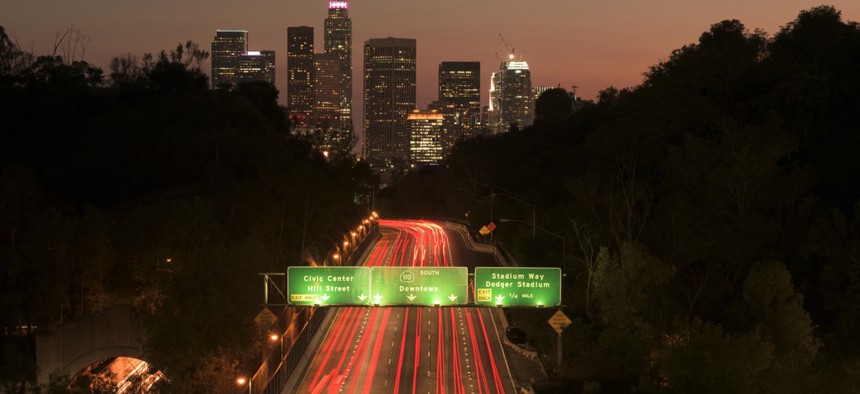Ending Traffic Congestion: Innovations in Policy, Technology Are Cause for Optimism

Chones / Shutterstock.com
U.S roads and highways were once the best in the world, but altered commuting patterns and declining gas tax revenues necessitate new approaches to transportation.
As anyone who has tried to get anywhere in the Washington, D.C., area knows, traffic congestion is a constant frustration that robs valuable productivity from the economy and erodes the region’s quality of life.
Commuting patterns increasingly burden roads not designed for dense traffic, as more jobs and people travel among revitalized urban cores and growing suburban mixed-use developments. This challenge is repeated in interconnected, urban-suburban regions like D.C. all across the country.
Countless planning studies correlate declines in community livability with inadequate investments in transportation systems. As vehicles are becoming more fuel-efficient every year, falling gas tax revenues are unable to keep pace with the growing backlog of highway investment needs.
Once, U.S. roads and highways were rated best in the world but now rank No. 16, according to the World Economic Forum.
The U.S. Department of Transportation estimates that nearly $123 billion per year, at minimum, is required to maintain and improve the condition of the nation’s roads and bridges, yet Congress is considering a funding level that is less than half this amount. Clearly, the traditional reliance on public funding mechanisms is no longer up to the daunting task of providing for U.S. infrastructure needs today, let alone tomorrow’s requirements.
These fiscal realities are worsening even as communities are focusing more policy efforts on adding and widening roadways, improving mass transit systems and encouraging carpooling, walking and bicycling.
It can seem like a hopeless problem. However, new approaches to transportation technology and new ways of thinking about smart, connected infrastructure offer reason for optimism, both in the United States and other developed countries.
Combined with new investment approaches for revitalizing transportation infrastructure, these innovations can serve as roadmaps to a more livable and productive future.
To get started, policymakers, infrastructure industry players and consumers need to better understand a couple of vital drivers.
Two Principal Drivers
The first is to adopt a “think different” policy approach to financing, developing and maintaining these critical infrastructure systems. The American Society of Civil Engineers—along with other public and private U.S. infrastructure research and policy groups—are already advocating to the nation’s policymakers that public-private partnerships, or P3s, are key to getting out of the rut that has led to failure to keep pace with transportation infrastructure needs.
The benefits of the shared risk and reward approach of these public-private partnerships are emerging as a reliable way to bridge funding gaps, lower project lifecycle costs, accelerate delivery timetables, and improve long-term operation and maintenance. P3s, when properly structured, allow private companies to take on more of the risks and protect taxpayer funds.
The second is to “road test” in real-time operations the available new technology applications that can improve transportation network management and the overall experience for drivers—in partnership between public and private entities and the public users of the roadways. Although embracing new technology carries inherent risks, it also offers potential for vastly greater gains when compared to traditional methods to relieve congestion and improve the safety of the nation’s roads.
Again, P3s can help to directly lessen the risk governments take on when applying new approaches.
Already today, there are a variety of innovative ways that technology is proven to work in higher-density corridors within cities and between urban areas to more efficiently manage traffic flows, reduce the damage to roadway infrastructure—thus improving maintenance and ongoing operations—and strengthening safety for the traveling public. A few examples include these types of roadway measures:
- Dynamic demand pricing
- Variable speed signs
- Lane management guides
- Over-height detection
- Weight-in-motion sensors
As the shift to smart vehicles accelerates rapidly—the Global Mobile Operators Association forecasts that roughly half of all vehicles sold by the end of 2015 will provide Internet-connected solutions—we can expect to see more highways with accurate vehicle tracking technology to accomplish several important objectives between now and the end of the decade:
- Support for newer road user pricing models
- Improved data analytics and real-time communication interfaces
- Better integration of traffic management systems with onboard vehicle technology and mobile devices
With application of traffic sensors and car/infrastructure communication, we will usher in the future of connected smart cities and literally pave the way for the introduction (and adoption) of driverless.
As our cities grow, it becomes increasingly difficult to simply continue with our traditional approaches, building our way out with major capacity additions. New policy approaches like P3s combined with new technology are essential routes to this better future.
Clearly the adoption of demand pricing—seen with HOT lanes, Uber, parking spaces, even public transit fares—is a vital part of the solution for both the short and long term as communities seek to manage resources and encourage behavior changes, while still providing options at a guaranteed level of service.
Backed by innovative financing and technology, traffic congestion isn’t an insurmountable scourge of modern living. We are at a crossroads, where we have the choice to make breakthrough progress.
The stakeholders to our transportation system need to understand and embrace new ways of future-proofing this important infrastructure so everyone can benefit from more commuter-friendly and productive cities that support quality living standards, as well as delivering economic stimulus and international competitiveness for the nation.
Jennifer D. Aument is Group General Manager, North America for Transurban, where she leads the company’s U.S. business.
NEXT STORY: For today's government data security, trust no one





